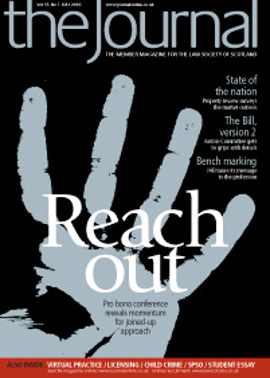Book reviews

Hilary Patrick and Nicola Smith
PUBLISHER: BLOOMSBURY PROFESSIONAL
ISBN: 9781847664877
PRICE: £38
This is a useful book for all professionals involved with adults at risk or in need of protection. The book deals clearly with the Adults with Incapacity (Scotland) Act 2000, recently amended by the Adult Support and Protection (Scotland) Act 2007. In addition, the Mental Health (Care and Treatment) (Scotland) Act 2003 is dealt with in full.
These were important pieces of legislation, but their complexities can unnerve the lawyer who deals with this field occasionally. The book is a helpful guide for lawyers, with appropriate footnotes to identify the relevant statute, case law or text. Other professionals such as doctors, social workers and mental health officers will find the text useful given the increase in multi-disciplinary working and information sharing. It is of a handy size to read in full but also a useful source of reference. If the answer to the reader’s question is not within the text, reference will be made to more detailed sources.
The principles of the three main statutes are clearly explained and there is a useful chapter on the key organisations and individuals who may become involved when an adult is at risk. The roles of the local authority, the Care Commission, the Public Guardian and the Mental Welfare Commission are fully explained, as are those of the police and prosecution service where criminal proceedings may be involved. In some such cases the fiscal may decide to divert the accused away from court proceedings and, in certain situations, to the civil procedure set out in the 2003 Act. In other cases, the civil procedure may be judged more suitable after an assessment under the Criminal Procedure (Scotland) Act 1995.
The five key principles of the 2000 Act are highlighted, namely that interventions will benefit the adult, the least restrictive option should be deployed, the views of the adult should be considered, respect should be given to others affected, and arrangements should encourage the use and development of the adult’s skills. The 2007 Act has built on these principles, emphasising the need to avoid discrimination and respect the adult’s background and characteristics.
There is a useful chapter on harm and abuse that may be encountered in adult protection cases. Definitions are given highlighting the different contexts and legislation that may be in point.
The considerations involved in supporting an adult in need of protection are fully examined, and various initiatives which may be deployed using statutory and informal powers are described. In a similar vein, the various measures open to the court both criminally and civilly to afford protection to vulnerable adults are explained, and these chapters are likely to be of great practical benefit to the practitioner who may be faced with a situation that is not straightforward or occurs infrequently in one’s own practice.
The 2007 Act placed a general duty on the local authority and other specific bodies to co-operate with one another. The authors cover this area and highlight the duties on public bodies and the Scottish ministers in this context under the Human Rights Act 1998.
A general chapter discusses court powers and procedures. In relation to applications for intervention or guardianship for adults with incapacity it might have been helpful to have mentioned the Sheriff Principal’s Practice Note No 1 of 2006, para 6 in force in Glasgow and Strathkelvin, which lists the important matters which require to be covered. The authors do, however, provide a helpful checklist of the best way to communicate with witnesses who have special needs. The use of the “appropriate adults” scheme is also covered. This is helpful as the scheme, which rests on Scottish Government guidance, is not as well known as it might be.
An inevitable consequence of care in the community is that adults with special needs may come into contact with the police and other authorities, as a suspect or accused or witness.
The authors explain the different considerations that require to be borne in mind in these situations.
While a work of this type is understandably light on history, background and development of the law, the authors conclude by looking at future developments. Although the law is stated as at 31 August 2009, reference is made to the Offences (Aggravation by Prejudice) (Scotland) Act 2009, which came into force on 24 March 2010.
The authors are to be commended for drawing on their extensive experience to distil the essentials into a concise, readable book.
- (Sheriff) Frank R Crowe, Edinburgh
In this issue
- Drop everything
- Free to give
- For the common good
- "Not for the likes of me"?
- RoS fees up for review
- Taking shape
- Criminalising children
- Split decision
- A picture's worth a thousand words
- "Duty to trade" revisited
- Law reform update
- From the Brussels office
- Join the cloud
- Combating claims in interesting times
- Ask Ash
- Party confidential
- What fresh hell is this?
- Links with the past
- Stranger than fiction
- Acts of kindness
- Scottish Solicitors' Discipline Tribunal
- Website review
- Book reviews
- Service driver
- Forecast: cloudy






